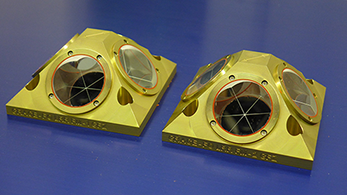06.08.2015: The satellite tandem GRACE (Gravity Recovery And Climate Experiment) Follow-On is well on its way for a start of its mission to space in August 2017. A technical assessment of its subsystems by the primarily responsive space agency NASA in July came to positive results. The German contributions to the satellite mission are coordinated by GFZ. Commence of construction is now enabled.
GRACE Follow-on is the follow up mission of GRACE, another satellite tandem that started in 2002. A novel Laser Ranging Interferometer (LRI), designed and technically implemented by the Max Planck Institute for Gravitational Physics (Albert Einstein Institute, AEI) in Hannover, is supposed to increase measuring accuracy of the distance between both satellites by about 50 times compared to the predecessor mission. „With the LRI it will now be possible to gain much more precise models of the Earth‘s gravity field and, based on the long time series of data from GRACE and GRACE-FO, reliable information on climate change” states Prof. Frank Flechtner, head of GFZ section Global Geomonitoring and Gravity Field and project leader of the mission at GFZ. GFZ furthermore provides Satellite Laser Retroreflektors (LRR) that allow for an exact location of the satellites.
The satellite tandem will circle Earth consecutively at a height of 490 kilometres in the same orbit at a distance of about 220 kilometres to each other. Variations in the distance will be measured most precisely by microwave engineering technique that allows for an accuracy of 0,002 millimeters for modeling Earth’s gravity field in the overflown terrain. Thereby it is now possible to monitor climate change indicators like the meltdown of polar ice caps or changes in ocean currents or in the global hydrologic cycle. The construction of the satellites will now be executed by partners from industry.









![[Translate to English:] Torsten Sachs in front of a climate station on a field](/fileadmin/_processed_/3/9/csm__TorstenSachs_bearbeitet_GS_4a1365ef84.jpeg)

![[Translate to English:] left image flood at the Ahrtal: image from above, several houses are flooded; left image:: Heidi Kreibich;](/fileadmin/_processed_/4/4/csm_Bild2_9af0130e9f.png)



![[Translate to English:] Start der Vega Rakete](/fileadmin/_processed_/6/4/csm_20231201-kachel_Vega-VV23-launch_ESA-CNES-Arianespace_706716b68c.jpeg)









![[Translate to English:] Poster exhibition at the Brandenburg Hydrogen Day at the GFZ, some participants in the foreground](/fileadmin/_processed_/6/5/csm_Erster_Brandenburgischer_Wasserstofftag_GFZ_402fcec95e.jpeg)
![[Translate to English:] Group picture of the participants](/fileadmin/_processed_/9/4/csm_20231108_CAWa-Workshop-Tashkent_Gruppenbild_99ea779d8a.jpeg)

![[Translate to English:] [Translate to English:] Hörsaal](/fileadmin/_processed_/e/6/csm_H%C3%B6rsal_e21ac645fb.jpeg)


![[Translate to English:] The Delegations in the Historic Library on the Telegrafenberg. In the back there are from left to right, the Dutch Ambassador for Germany, Ronald van Roeden, the Dutch Minister for Education, Culture and Science, Robbert Dijkgraaf and the scientific director of the GFZ, Susanne Buiter.](/fileadmin/_processed_/d/b/csm_Kachel-2_9eba4b4212.jpeg)

